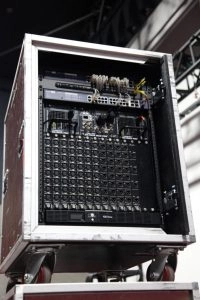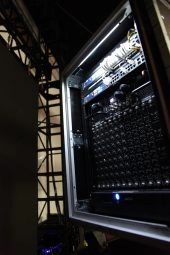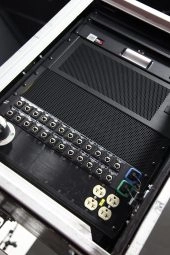ALFORD ADVANCES SHOW SITE NETWORKING WITH A-LAN
 Innovating and improving processes is one of Alford’s greatest strengths and is in large part due to the creative thinking and collaboration of our people. Each department is filled with individuals who strive to design superior and more efficient ways to accomplish the work they’re passionate about. While we are typically renowned for our expertise in sound, lighting and projection, one of our more recent innovations involves an equally important, but not as obvious aspect of the event, the networks we use on site for running the gear. Alford’s Audio Manager, Ben MacKinney, and Audio Engineer, Ryan Sartell, have created a more reliable network for show critical systems to operate on, aptly calling it Alford’s Local Area Network (A-LAN).
Innovating and improving processes is one of Alford’s greatest strengths and is in large part due to the creative thinking and collaboration of our people. Each department is filled with individuals who strive to design superior and more efficient ways to accomplish the work they’re passionate about. While we are typically renowned for our expertise in sound, lighting and projection, one of our more recent innovations involves an equally important, but not as obvious aspect of the event, the networks we use on site for running the gear. Alford’s Audio Manager, Ben MacKinney, and Audio Engineer, Ryan Sartell, have created a more reliable network for show critical systems to operate on, aptly calling it Alford’s Local Area Network (A-LAN).
 Most event technicians operate a system similar to Alford’s previous method of using multiple routers, comparable to an in-home Wi-Fi device. Each department then manages their own network, sometimes multiple independent networks per department. Utilizing basic wireless connections for an event’s PA control system is often used in a very simplistic, but unreliable way. At any typical event, you might see several routers being used at front of house and backstage. These are then spread out and set up for varying speeds and distances, requiring multiple technicians to install and maintain them throughout the event.
Most event technicians operate a system similar to Alford’s previous method of using multiple routers, comparable to an in-home Wi-Fi device. Each department then manages their own network, sometimes multiple independent networks per department. Utilizing basic wireless connections for an event’s PA control system is often used in a very simplistic, but unreliable way. At any typical event, you might see several routers being used at front of house and backstage. These are then spread out and set up for varying speeds and distances, requiring multiple technicians to install and maintain them throughout the event.
While it’s a widely used technique, there are many reasons this method has become inferior as the industry has grown. Historically, there were only one or two systems that required network connections to function; therefore, there was not much time invested to get them running. However, with today’s technology, almost every system running requires some type of network connection. The amount of labor it requires to set up and adjust the connections can become time-consuming and not very cost effective, particularly for large venues. Another concern is the congestion of the wireless spectrum that Wi-Fi operates in. When there are many different wireless routers operating at the same time, they are clogging the spectrum reducing their operating speed and ranges. Add a few thousand cellphones to the mix and the convenience of Wi-Fi shrinks to a range and speed that make it not so convenient. While all of our systems do not require Wi-Fi to work, it is an added bonus when we can still monitor the systems remotely.
The audio department’s solution was to create a more robust and easier to manage system that would be more akin to a building’s network, or local area network (LAN). “We now spend less time setting up networks since its plug-and-play. Instead of having 3 different techs setting up networks, the audio department plugs in the system and everybody jumps on,” explains Ben. So, in order to gain necessary speed and range for video’s, lighting’s, and audio’s systems, it requires a higher capacity network with built-in redundancy. For this need our solution is centered around Luminex’s family of GigaCore switches. With a varied assortment of different sizes and port counts, Luminex is able to cover all of our needs.
 Once the switches were placed in all necessary consoles, we then installed two wireless access points- one at front of house and one backstage. This creates a mesh network allowing for techs to walk hundreds of feet away with their tablets and remain connected to their projectors or PA’s through whichever access point near them is strongest. “Our new access points are professional grade, with a very high capacity for users in the hundreds,” said Ben. With the time saved and wireless efficiency gained, it’s our clients who reap the benefits. Our system’s reliability guarantees a flawless connection for every show. Now, all Alford’s audio consoles with 48 channels or greater have built-in A-LAN’s and are being used at our client’s corporate events, conferences, and in large venues.
Once the switches were placed in all necessary consoles, we then installed two wireless access points- one at front of house and one backstage. This creates a mesh network allowing for techs to walk hundreds of feet away with their tablets and remain connected to their projectors or PA’s through whichever access point near them is strongest. “Our new access points are professional grade, with a very high capacity for users in the hundreds,” said Ben. With the time saved and wireless efficiency gained, it’s our clients who reap the benefits. Our system’s reliability guarantees a flawless connection for every show. Now, all Alford’s audio consoles with 48 channels or greater have built-in A-LAN’s and are being used at our client’s corporate events, conferences, and in large venues.
Alford is the only event technology company that offers this innovative system for wireless connection directly on show site. With all of our departments linked up to the same switch systems, setting up equipment for an event has never been more simple or seamless than now.









